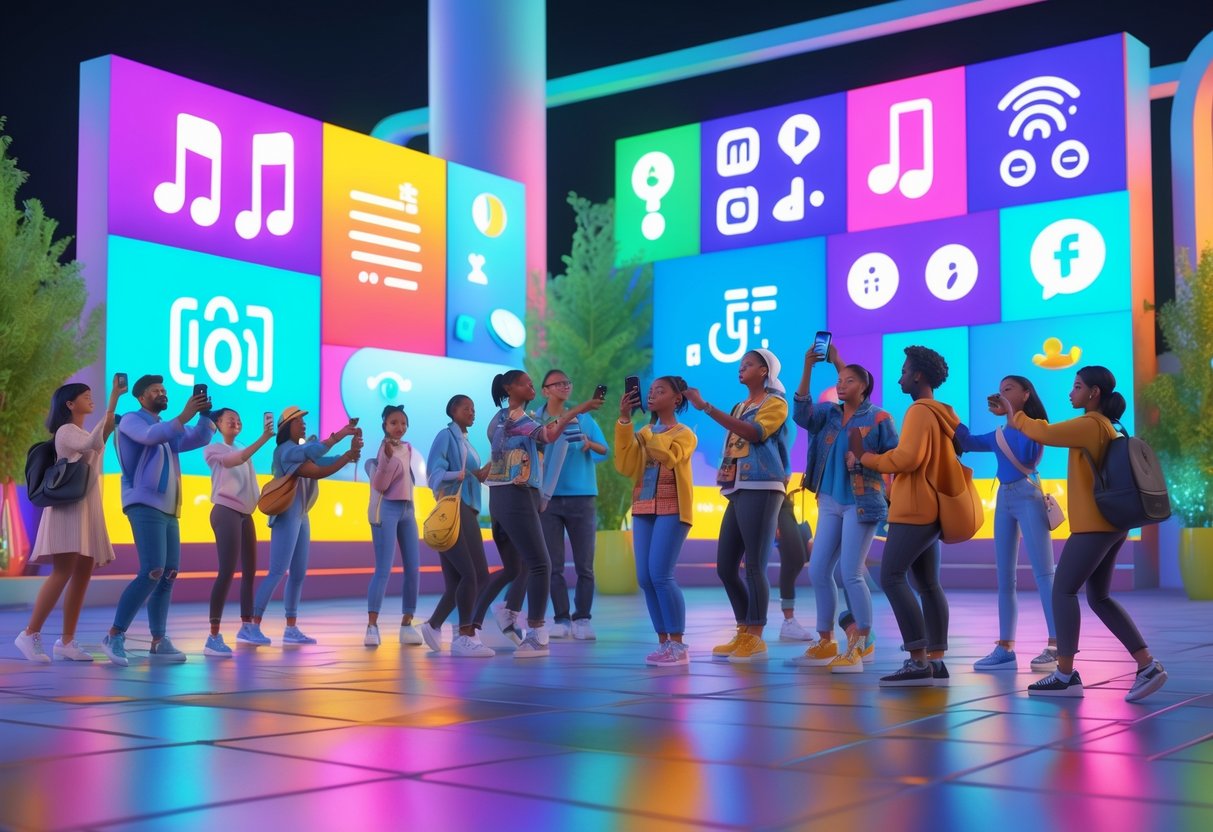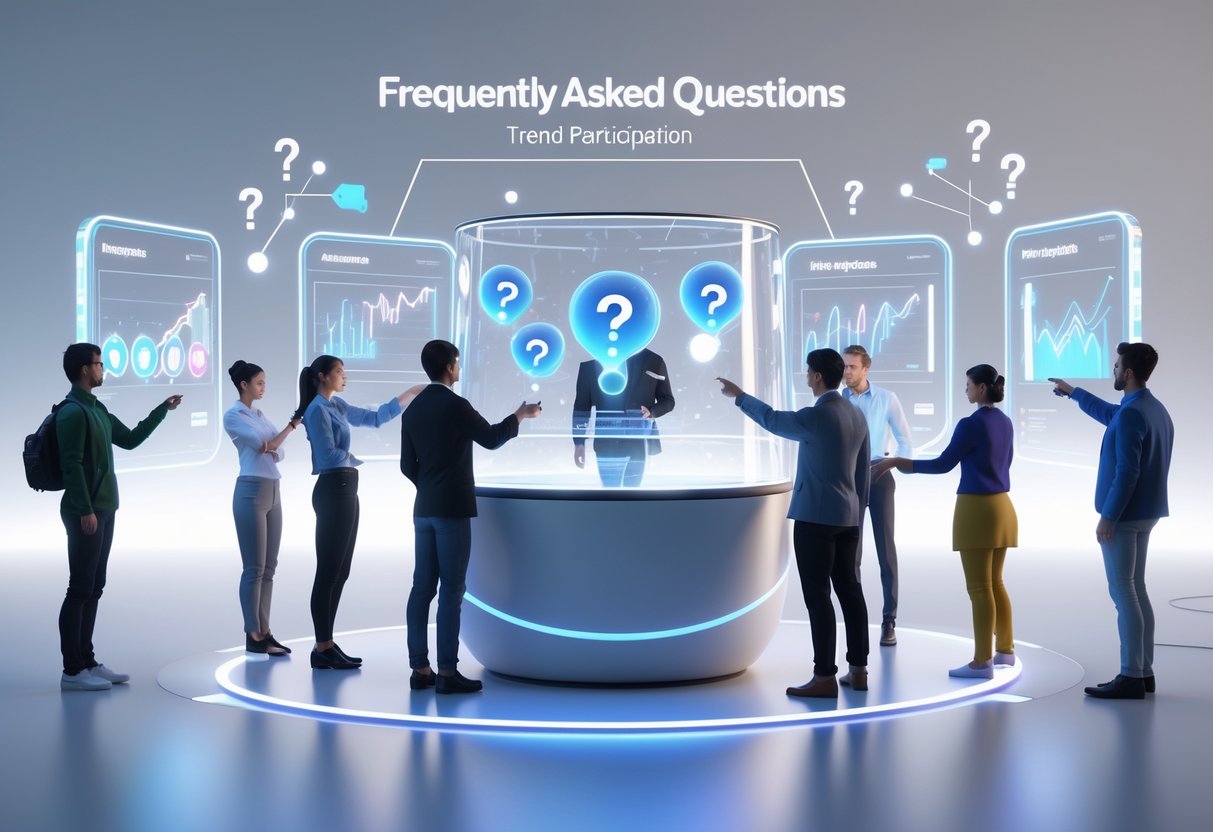Trend Participation: Maximising Influence and Relevance Online
Updated On: October 24, 2025 by Aaron Connolly
Understanding Trend Participation
Trend participation is all about jumping in on cultural moments, social movements, or popular patterns that sweep through communities. Sometimes that means tackling viral social media challenges, other times it’s about riding the wave of bigger cultural shifts in gaming and esports.
Definition of Trend Participation
When we talk about trend participation, we mean making a conscious choice to get involved with whatever’s buzzing in the community. Maybe it’s a new gaming challenge or experimenting with the latest streaming style.
Players often pick up new game mechanics the second they catch on. Remember when battle royale games took over? Streamers who jumped in early really kept their audiences engaged.
Timing is everything here. If you’re quick to spot and join a trend, you can build stronger bonds with your community. Sometimes you might even help steer the trend itself.
Quick win: Keep an eye on esports social media. Catch those trends before everyone else does.
Key Characteristics of Trend Participation
Authenticity really matters. Audiences can sniff out when someone’s just chasing clout instead of genuinely enjoying the trend. Esports fans especially want the real deal.
You’ve got to pick your moment carefully. Jump in too soon and no one’s interested yet. Wait too long and you risk looking outdated—or just desperate.
Warning: Forced participation? It almost always backfires in gaming communities.
There’s a bit of risk, too. Not every trend fits every brand or audience. Some fade out overnight, while others stick around and become part of gaming culture.
Smart esports organisations don’t just follow every trend. They pick the ones that fit their audience and brand identity.
Historical Evolution of Trends
Gaming trends have come a long way, evolving from simple viral clips to full-blown cultural movements. Back in the day, forums and email chains spread the word.
Now, social media platforms like Twitch and TikTok can launch a trend to millions of gamers in just a few hours.
Modern trend lifecycle:
- A creator or community sparks something new
- It spreads fast across social media
- Engagement peaks for a few days or weeks
- Eventually, it fades or morphs into something else
Esports trends now even reach mainstream media. Big tournaments can spill over into general entertainment news.
Participation strategies have changed too. Early on, trends just sort of happened. Today, content creators and organisations often coordinate to make trends take off.
The Psychology Behind Trend Participation
We chase trends because our brains crave social proof and acceptance. These psychological drivers shape everything from viral TikTok dances to the latest esports merch.
Social Proof and Peer Influence
Social proof is our go-to shortcut when we’re unsure what’s cool. We just look around and see what everyone else is doing.
That’s why when a big streamer picks up a new game, viewership skyrockets. People think, “Well, if they’re into it, maybe I should check it out too.”
Authority figures crank this up even more. When top esports players try new gear or strategies, fans quickly follow. Mia Kwan, a gaming journalist, points out that pro endorsements can shift entire communities almost overnight.
Trends ripple outwards. They might start with the pros, then reach semi-pros, and finally land with casual players through streams and social media.
Quick win: Think about the trends you’ve picked up after seeing them everywhere. That’s social proof doing its thing.
Desire for Belonging and Acceptance
We join trends because we don’t want to be left out. FOMO (fear of missing out) is a huge driver, especially in gaming where things move fast.
Being part of the “in-group” just feels good. In esports, that could mean sporting a team jersey, using new slang, or playing the same games as your friends.
Trends give us social currency—something cool to share or talk about. Knowing the latest meme or understanding a new mechanic helps us connect with others.
Warning: This urge to belong sometimes leads to buying stuff we don’t need—like that pricey gaming mouse—just to fit in.
Our brains reward us for joining in. Every like or comment on a trending post gives us a little dopamine hit, making us want to do it again.
Types of Trends and Their Contexts

Knowing the different types of trends helps us join esports conversations more effectively. Viral trends move fast on social media, while industry-specific trends shape the competitive gaming world over time.
Viral Trends in Social Media
Viral trends in esports can blow up on TikTok, Twitter, or Instagram in no time. These usually revolve around clutch plays, funny moments, or memes that gamers everywhere relate to.
Think of the “What’s your main?” challenges or reaction videos to big tournament upsets. They spread because they’re easy to copy and tap into shared experiences.
Esports teams love jumping on viral trends to reach younger fans. You’ll see players trying dance challenges or riffing on hashtags like #GamersReact.
Warning: Not every viral trend fits a pro team’s image. Staying authentic is key.
Timing matters. The best creators join trends just as they’re heating up, and they always add their own spin.
Industry-Specific Trends
Industry trends in esports build slowly. They might take months or even years to really shape things. Examples? The rise of mobile gaming competitions, women’s leagues, or university esports programmes.
Right now, franchised leagues are replacing open tournaments. Overwatch League and the League of Legends Championship Series use permanent team slots, which changes how players build their careers.
Hybrid events—mixing online and offline play—have stuck around since the pandemic. They’re cheaper and let more people join in from around the world.
Regional differences matter a lot, too. In the UK, FIFA and CS2 are big, while in Asia, mobile titles like PUBG Mobile dominate.
Spotting these patterns helps us guess which games might blow up next. It also shows where the career opportunities are heading.
Identifying the Right Trends to Join
Not every viral hashtag deserves your esports brand’s attention. You’ve got to weigh trends against your brand values, make sure they’ll click with your audience, and figure out if they’ll last longer than a day or two.
Relevance to Brand Values
Your brand values should guide which trends you join. If your organisation stands for inclusivity, it makes sense to support trends that push diversity in gaming.
James Connolly, a gaming expert, says, “brands that align trends with their core values see 40% better engagement than those chasing every viral moment.”
Think about your mission statement. A gaming academy might join educational trends, while a streaming brand might lean into entertainment-focused ones.
Red flags:
- Trends that go against your values
- Content that could turn off loyal fans
- Topics you don’t really understand
Ask yourself, “Does this trend fit our brand?” If you’re not sure, maybe skip it.
Alignment with Target Audience
Your audience decides which trends are worth your time. Esports fans aged 16-25 look for different things than industry insiders or casual viewers.
Check out how your audience uses each platform. Instagram is big for visual trends, Twitter for conversations, and TikTok for quick, fun content.
Watch what your community does. Which hashtags pop up? What do they share? Their habits should shape your approach.
Don’t forget about time zones. If your fans are mostly in Europe, joining a North American trend might mean missing your peak hours.
Quick audience check:
- Are your followers already into this trend?
- Does it match their interests?
- Will it actually add something to their feed?
Evaluating Trend Longevity
Some trends are gone in a day; others stick around for months. Knowing which is which helps you decide how much effort to put in.
Short-term trends (a day or two) are good for quick posts or reactions. Medium-term trends (a week or so) let you plan out tutorials or commentary.
Long-term trends (months) deserve more investment. Think seasonal events or big tournaments.
Watch how trends move across platforms:
- Rising: Good time to jump in early
- Peaking: Lots of eyes, but lots of competition
- Fading: You risk looking behind the times
Use Google Trends or social listening tools to check momentum. If something’s dropping off fast, maybe don’t bother with a big video.
Trends tied to major esports events or updates usually last longer than random viral moments.
Benefits of Trend Participation for Brands

When brands jump on viral trends, they can score big wins in today’s fast-moving digital world. The big perks? Massive exposure, higher engagement from your fans, and stronger brand recognition that keeps you top-of-mind.
Enhancing Visibility and Reach
Posts that tap into trending topics get 1.5x more engagement than regular ones. Social media algorithms love content that matches what people are already talking about.
Brands that join trends early reach way beyond their usual followers. The trend shines a spotlight, putting them in front of people who might never have found them otherwise.
Quick exposure perks:
- Access to huge trending hashtags
- More organic shares from users who relate
- Algorithms push your stuff to more feeds
- Cross-platform reach as trends jump networks
But timing is tight. You usually have just 24-48 hours to make the most of a trend before it fades. Miss it, and you miss out.
Fostering Engagement and Interaction
Trends give brands an easy way to start conversations with fans. People love to engage with content that references what’s already buzzing.
You’ll see more comments, shares, and even user-generated content as fans riff on your take. Folks want to see brands put their own spin on trends—so long as it feels real.
Engagement goes up with:
- More comments on trend posts
- Shares as users tag friends
- Fans making their own versions
- DMs and mentions from excited community members
Gen Z especially loves brands that “get it” and show cultural awareness. But if your content feels fake, they’ll call you out in a heartbeat.
Building Brand Recall
When brands jump into trends and actually nail it, they create moments that stick in people’s minds. These moments turn into reference points folks remember long after the trend fades.
Memory-building happens through:
| Factor | Impact |
|---|---|
| Cultural relevance | Creates shared experiences with target audience |
| Emotional connection | Links positive feelings to brand identity |
| Timing association | Brands remembered for being “first” or “best” at trends |
| Shareability | Repeated exposure through social sharing |
The best trend participation doesn’t just follow the crowd—it brings the brand’s own flavor into the mix. That makes companies stand out while still riding the trend’s momentum.
Brands that keep up with relevant trends earn a reputation for being in tune with culture and quick to respond to what their audience cares about.
Crafting Authentic Brand Responses to Trends

When esports brands jump on trends, timing and authenticity matter most. The best responses feel natural and actually add something, instead of forcing a connection just for the sake of it.
Balancing Timeliness and Brand Voice
Quick responses to trends pull attention, but they need to sound like your brand. The most successful esports brands set clear rules about which trends fit and which don’t.
Gaming brands like Riot Games get this right. When memes pop up from their games, they jump in quickly but always keep their playful-yet-professional style. They avoid trends outside gaming culture because it wouldn’t feel real.
Create response templates that match your brand’s voice. This helps your social team move fast and stay on message. Include phrases, tone pointers, and real examples.
Set hard deadlines for trend responses. In esports, trends often last just 24-48 hours. If you can’t respond within 6-12 hours, odds are you’ve missed the window.
Heads up: Don’t ditch your brand’s personality just to be fast. A late but genuine response beats a rushed, bland one every time.
Decide which trends fit your values before they even appear. With gaming culture moving so quickly, having principles set up helps teams decide fast.
Showcasing Creativity and Originality
The brands that get noticed don’t just follow trends—they remix them. Creative responses show you get both the trend and your audience, and can blend them in clever ways.
Check out how esports orgs handle meme trends. The best ones don’t just copy; they twist the format using their own players, inside jokes, or game references their community loves.
Build on trends—don’t just mimic. Take the main idea, but run it through your brand’s unique lens. That makes content feel both familiar and new.
Use your brand’s specific expertise to add value. If you’re a coaching platform, turn viral moments into quick lessons. Hardware brands can break down trending plays from a technical angle.
Work with your community when making responses. Esports fans often have the best takes on how brands should join trends—they get both the culture and your place in it.
Keep a handy library of your brand assets, catchphrases, and visuals ready to remix. This keeps you culturally relevant and makes sure every trend response feels like yours.
Risks and Challenges in Trend Participation
Jumping into trends in esports can backfire. You might hurt your brand, push away core fans, or stumble into cultural mistakes that stick around for a long time. Knowing these risks helps you pick which trends are actually worth it.
Brand Safety and Reputational Risk
Chasing the wrong trends can wreck your esports brand’s credibility. If you jump on every viral wave, you risk losing the authentic voice that built your community.
Imagine this: A gaming org joins a dance trend totally unrelated to their values. Their diehard fans get confused and feel left out.
Quick research saves you from big headaches. Before you join a trend, check where it started and what it really means. Some viral challenges look harmless but come with baggage.
| Risk Level | Example | Impact |
|---|---|---|
| Low | Gaming memes | Minimal brand confusion |
| Medium | Celebrity endorsements | Potential audience mismatch |
| High | Political movements | Major backlash risk |
Pro tip: Always get someone else to look at trend-based content before posting. What cracks up your team might upset your global audience.
Avoiding Trend Fatigue
If you chase every trend, your brand starts to look desperate, not authentic. Your fans come for gaming content, not random viral moments.
Lots of esports creators notice that posting too many trends actually drops their core engagement rates. Fans want insights and tournament news, not just whatever’s trending.
Set limits for trend posts. Gaming expert James Connolly says to keep trend content to 20% of your total posts. That way, your brand identity stays strong, but you can still be creative.
Stick to gaming-related trends that fit your space. If you make Valorant content, join Valorant trends. Jumping on cooking trends? Probably not.
Quick win: Make a monthly content calendar with your main gaming topics first. Only add trends that support those themes.
Cultural Sensitivity and Appropriation
Cultural moments in gaming need extra care, especially with a worldwide esports audience. What’s cool in one place might be offensive somewhere else.
Regional gaming cultures have deep roots. If you use these cultural references without understanding them, you risk turning off entire communities.
Do your homework before joining in. If a trend starts in a specific gaming community or culture, make sure your participation feels respectful, not exploitative.
Many esports orgs work with international fans. One slip-up with cultural relevance can hurt relationships across several markets at once.
How to stay culturally aware:
- Ask team members from different backgrounds
- Look up the trend’s origin and meaning
- Think about how it plays in each region you serve
- Skip trends you don’t fully get
Heads up: Gaming communities remember. Cultural missteps can haunt your brand for years and even cost you sponsors or loyal fans.
Measuring the Impact of Trend Participation

Success in trend participation isn’t just about counting likes and shares. You need to track real metrics that show business impact and figure out if all that engagement actually leads to conversions.
Key Metrics for Assessing Success
Participation Rate is where you start. Track how many community members actually get involved versus those who just watch.
Active participants comment, share, and create trend-related posts. Passive ones might just watch streams or scroll by.
Engagement Depth shows you the quality of participation. Measure comment length, discussion activity, and time spent on your trend content.
For esports brands, this could mean:
- Average watch time on trend-focused streams
- Comments per trending post
- User-generated content submissions
- Tournament sign-ups related to trends
Reach and Amplification show how far your trend spreads. Track shares, reposts, and mentions across platforms.
When people share your trend content with their own networks, your brand visibility grows. Honestly, this kind of organic spread often beats paid ads.
Sentiment Analysis tells you how people feel. Positive participation builds brand love, but negative reactions can hurt.
Watch keywords, hashtags, and the tone of comments to read the room. If you see mixed feelings, it might mean the trend clicks with some fans but not others.
Analysing Engagement Versus Conversion
High Engagement, Low Conversion happens a lot with trends. Viral posts might rack up likes but barely move sales or sign-ups.
Track the path from trend participation to real actions—like newsletter signups, purchases, or tournament registrations.
Quality matters more than quantity when judging trend success. A smaller, passionate group often brings better results than a huge but passive crowd.
For esports orgs, meaningful conversions could be:
- Tournament entries from trend fans
- Merch sales tied to trending campaigns
- Streaming subscriptions
- Team applications
Attribution Challenges make it tough to link trends directly to business results. Use tracking links, special landing pages, and surveys to see where conversions come from.
Long-term brand building is probably the biggest win from trend participation. Fans who join in now might stick around and become loyal, even if they don’t convert right away.
Measure repeat engagement, community growth, and how often people mention your brand to see these long-term effects. The right trend participation builds relationships that pay off down the road.
Trend Participation Strategies for Different Platforms

Every platform has its own vibe and way of spreading trends. If you’re after gaming audiences on TikTok or joining cultural moments on Twitter, you need to play by each platform’s rules.
Social Media Networks
TikTok leads the pack for trend creation. Its algorithm loves new content that gets quick engagement. Gaming creators do best by jumping on trends within a day or two.
The platform values authenticity over fancy production. Simple gaming clips using trending sounds or challenges often beat super-edited videos.
Instagram is all about polished visual content. Gaming highlights and tournament moments shine here. Stories and Reels are your best bet for trends, while feed posts need more careful timing.
Gaming brands use Instagram to show off cultural moments with high-quality screenshots and behind-the-scenes peeks. The platform’s 41% preference among marketers for trend response shows its strength in visual storytelling.
Twitter is the home for real-time conversations about gaming events and culture. Trending hashtags move fast, so you need to react right away.
Quick takes on tournament results, game updates, or news usually get more traction than prepped posts. Twitter rewards fast, relevant commentary.
YouTube handles trends with longer-form content that digs deeper. Creators break down viral moments, explain shifting gaming culture, or teach trending strategies.
Offline and Hybrid Trends
Gaming events open up trend opportunities that cross online and offline. Tournament attendance, meetups, and local gatherings spark content that resonates everywhere.
Live streams from events capture raw, authentic moments that often go viral. These spontaneous clips and behind-the-scenes looks perform especially well.
Merchandise and physical products tied to viral gaming moments keep trends alive longer. Limited edition items, themed setups, or tournament merch extend the trend beyond digital.
Cross-platform campaigns work best when they play to each platform’s strengths but keep the messaging about gaming culture and community consistent.
Leveraging Cultural Moments for Trend Participation

Cultural moments give esports brands a huge chance to connect with audiences through shared experiences and conversations. By joining the right cultural conversations and jumping on timely events, esports orgs can build tighter community bonds and even reach new fans outside the usual gaming crowd.
Participating in Cultural Conversations
The most successful esports brands jump into cultural conversations when it feels natural—when something clicks with gaming culture or their community’s values. It’s not about chasing every trend; it’s about spotting moments that really matter to your audience.
Strategic alignment matters most. Before we dive into any cultural moment, let’s actually ask if it fits our brand voice and if it serves our community’s interests. A fighting game tournament organizer might talk about competitive spirit during the Olympics. An esports coaching platform might join conversations about mental health awareness in a way that feels real.
Authentic participation beats forced relevance every time. Audiences can tell when we’re genuinely part of a conversation versus when we’re just chasing clicks. Gaming communities care a lot about authenticity—they’ll call us out if we fake it.
Try these approaches:
• Share honest perspectives on cultural topics that overlap with gaming
• Amplify community voices during relevant cultural discussions
• Make content that actually adds something to ongoing conversations
• Use gaming analogies to help explain tricky cultural topics
Quick win: Keep an eye on gaming-adjacent conversations on Twitter and Reddit. Jump in where we actually know what we’re talking about—no need to add more promotional noise.
Capitalising on Timely Events
Major events open doors for esports brands to connect with bigger audiences through shared moments. We can tap into everything from sports finals to award shows, as long as there’s a real link to our community.
Timing is everything. Cultural moments move fast, especially online. We need systems that spot relevant events early so we can respond while they’re still hot. If we miss the peak, we’ve probably missed the whole opportunity.
Event alignment strategies include:
| Event Type | Esports Application | Example |
|---|---|---|
| Major sports finals | Competitive parallels | Compare World Cup pressure to esports championships |
| Award ceremonies | Celebrate gaming achievements | Highlight esports moments during film/TV awards |
| Cultural holidays | Community building | Gaming marathons during charity awareness days |
| Breaking news | Expert commentary | Discuss gaming industry implications |
We can create event-specific content that serves our community and nods to the bigger cultural moment. Maybe we host watch parties during big sports events, or make content that draws lines between traditional sports and esports.
Warning: Stay away from sensitive cultural moments unless we really know the topic and have a connection to the community. Messing up during serious events can seriously hurt our reputation.
Building a Sustainable Trend Participation Framework

If we want to keep up with trends over time, we need a plan and smart resource use. The trick is finding the right mix of timely trend content and consistent brand messaging that keeps our audience coming back.
Integrating Trend Participation Into Marketing Plans
Let’s build trend participation right into our content calendars and marketing plans. We should set aside 20-30% of our content budget just for trend-based content.
Set up a trend monitoring system. We can track gaming hashtags, esports news, and community discussions every day. Google Trends and social listening tools help us spot emerging topics early.
Quick allocation framework:
- 40% evergreen content
- 30% seasonal/planned content
- 30% trend-responsive content
Decide ahead of time which trends are worth joining. We only jump in when a trend matches our brand values and our audience cares. Not every viral moment deserves our attention.
Have rapid response templates ready. Pre-approved formats for trend posts let us move fast without sacrificing quality. Think image templates, caption ideas, and a clear approval process.
Track trend content performance on its own. We measure engagement, reach, and conversions differently than we do with evergreen content. This data helps us decide which trends to join in the future.
Balancing Evergreen and Trend-Driven Content
Getting the balance right between trendy and timeless content shapes long-term success. Evergreen content forms our backbone, while trends give us bursts of attention.
Evergreen content gives us:
- Steady organic traffic
- Long-term SEO benefits
- Brand authority
- A reliable engagement baseline
Trend content brings:
- Viral potential
- Fast audience growth
- Community relevance
- Real-time engagement spikes
We stick with the 70-20-10 rule for sustainable balance: seventy percent evergreen guides, twenty percent seasonal content, and ten percent pure trend plays.
Whenever we post about a viral esports moment, we link back to evergreen guides. This way, trend traffic turns into long-term readers.
Keep an eye on content shelf life. Trend pieces fade quickly, but they should push traffic to content that lasts. We judge success by how well trends support our evergreen funnel.
The Future of Trend Participation

Algorithms keep getting smarter at guessing what grabs our attention, while people shift toward more genuine engagement with viral content. It’s changing the way we find and join online trends.
Evolving Algorithms and Trend Cycles
Social platforms now use advanced tools to spot trends before they blow up. Machine learning checks engagement, comments, and how fast people share stuff to predict what’ll go viral.
TikTok’s latest algorithm updates look at micro-moments, not just views. Trends might start smaller but feel more real as they spread.
Instagram and YouTube are trying out trend prediction tools that alert creators about rising topics in their niche. Creators who jump on these early usually get better reach.
Trend cycles move faster. What lasted weeks now peaks and fades in days. Platforms are reacting by:
- Showing “trending now” alerts sooner
- Prioritising fresh content over recycled stuff
- Testing 24-hour trend windows for certain categories
We’re seeing AI-generated trend suggestions that mash up different viral elements. These hybrid trends often outperform organic ones.
Predicted Changes in Consumer Engagement
Gen Z and Gen Alpha are getting pickier about which trends they join. They’re moving away from copying everything and focusing on meaningful participation.
Quality over quantity is the new vibe. Instead of hopping on every trend, people pick a couple each month that actually resonate.
Authenticity metrics matter more now. Platforms are trying out systems that spot forced or fake trend participation. Content that feels real gets pushed more.
Niche trend communities are rising. Viral content doesn’t always go mainstream anymore—specialised groups create their own micro-trends with higher engagement.
Cross-platform trend migration is speeding up. What starts on TikTok can end up on Instagram Reels, YouTube Shorts, or even LinkedIn in just hours. People expect trends to fit each platform’s style.
We expect AI-assisted participation tools to pop up soon. These might suggest ways to join trends that match your content and audience.
Frequently Asked Questions

The labour force participation rate tracks how many working-age people actually take part in the job market. Here are some quick answers about the basic formula, trends, and what shapes participation rates.
What is the formula used to calculate the labour force participation rate?
You get the labour force participation rate by dividing the labour force by the working-age population and multiplying by 100. The labour force includes both employed people and those who are unemployed but looking for work.
The working-age population usually covers people aged 16 and up who aren’t in places like prisons or long-term care. We leave out students, retirees, and others not job-hunting.
Could you explain the definition of the labour participation rate?
The labour participation rate shows what percentage of working-age adults either have a job or are actively hunting for one. It basically tells us how engaged people are with the job market at any point in time.
This rate helps economists get a feel for economic health and workforce trends. A higher rate usually means more people want to work, while a lower rate can signal problems or shifts in the population.
How has the labour force participation rate changed over the years?
Labour force participation rates have changed a lot over the years. Women’s participation jumped from the 1960s to the 1990s as more joined the workforce.
Lately, in many developed countries, participation has gone down. The 2008 financial crisis and the COVID-19 pandemic both caused drops in lots of places.
Aging populations play a big role too. As baby boomers retire, overall participation falls, even if younger people stay active in the job market.
Where can I find a chart comparing the labour force participation rates?
The Office for National Statistics (ONS) has UK labour force participation charts and historical data. Their site includes interactive tools so you can compare rates by time period or demographic.
The OECD Statistics database lets you compare participation rates across countries. You can see global trends and differences side by side.
Most government statistical agencies publish similar charts. The US Bureau of Labor Statistics and Statistics Canada both offer lots of participation rate data and visualisations.
How do the labour force participation rates compare to unemployment rates?
Labour force participation and unemployment rates measure different things and don’t always move together. Unemployment only counts people looking for work, while participation rates include all working-age adults in the labour force.
During recessions, participation rates can drop if discouraged workers give up looking for jobs. These people don’t count as unemployed, so unemployment rates might look better than the real job market.
Looking at both rates gives a clearer picture of labour market health. High unemployment and falling participation usually point to deeper economic problems than unemployment alone suggests.
What are the main reasons behind the decline in labour force participation rates?
Population ageing stands out as the biggest reason for falling participation rates in developed countries. When large generations retire, the workforce just shrinks compared to the rest of the adult population.
Educational trends shape this too. These days, more young adults stick around in university or training programs, putting off their entry into the job market. Sure, it means they get better job prospects later, but the delay is real.
Economic factors matter a lot. Some people get discouraged by long-term unemployment and just stop looking for work. Others might turn to disability benefits or take early retirement instead of staying in the workforce.
And honestly, some folks just decide to care for family members rather than chase paid jobs. There’s no single reason—it’s a mix of choices and circumstances.

